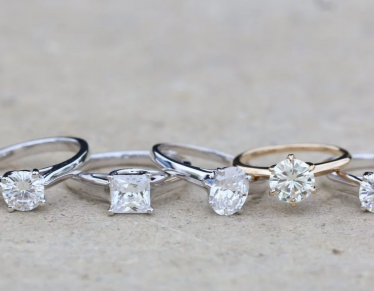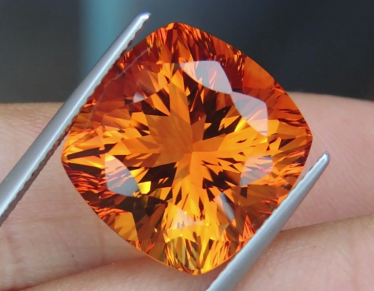If you prefer white colored jewelry (as opposed to metals like yellow gold or rose gold) you have two main options to consider: platinum vs white gold.
When it comes to selecting a new piece of jewelry, one of the main considerations is the type of metal you want. Based on the style, quality, and budget you have, you can start to narrow down your options and come to the right decision.
Without knowing the differences between platinum and white gold you won’t be able to make the right decision. While both are quality options to choose from and will last you a long time, there are significant differences to consider.
If you are unsure what the differences are between white gold and platinum, keep reading to learn everything you need to know.
From their difference in quality, to appearance, cost, and more, we are covering it all so that you can make the right decision.
What is Platinum
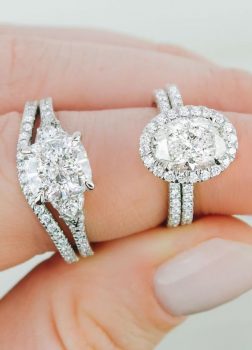
Let’s start with platinum! What exactly is platinum? You’ve probably heard it referred to as the ‘best’ type of metal you can get for something like an engagement ring. It is a very solid metal that has great durability and naturally has the beautiful white shining color to it.
It is a rarer metal, which alone makes it seem more valuable since it is not as easy to find. Far less of it is mined per year compared to other common metals like gold.
With platinum, you do not have to worry about things like corrosion or color change. It is naturally a white metal and will stay that way.
It is also hypoallergenic, making it a great option for anyone who has sensitive skin. This is because platinum is a pure metal, meaning that it is not mixed or alloyed with other metals that are common causes of skin reactions, mainly nickel.
In many ways, platinum is an excellent choice, especially when it comes to something like an engagement ring that will be worn every single day.
Having the most durable type of metal means it will hold up and look nice for far longer without needing repairs or polishing or things like that.
? Platinum Pricing
As you can imagine, platinum is very expensive. The one main downside that you will find with platinum is that it costs a lot more.
While it is certainly a premium metal and a great option, if you are working with a more limited budget it may not be the right choice for you.
One other reason why you will find platinum to be more expensive is because it is a lot denser of a metal. If you were to pick up two identical rings in every aspect except for the metal type, you would notice that the platinum ring would weigh a lot more than a ring in white gold or another metal.
Because precious metals like these are priced according to their weight, platinum is going to be more expensive every time.
Because platinum is a pure metal (to be considered a platinum ring it must have at least 95% platinum) it will also be more expensive and weighty because it is not mixed with other metals.
When dealing with white gold, you have varying karat amounts. If you go with a 14k white gold ring, you aren’t getting a pure gold ring.
This will also factor into the cost, as well as other factors like appearance which we will discuss later on.
What is White Gold
Your other option to consider is white gold. The main thing you need to know about white gold is that it is not naturally occurring. While platinum is a naturally white metal, gold is not.
Gold is naturally yellow, and so to get white gold, gold has to be alloyed with white-colored metals like silver, nickel, or palladium. It can also be dipped or plated in rhodium to give it more of a bright white appearance.
While pure gold itself is also hypoallergenic and resistant to things like tarnish and corrosion, it is far too soft of a metal to use in jewelry, especially something like an engagement ring that is worn every day.
That is why you will almost never see a piece of jewelry that is 24k gold, or pure gold. Instead, you will find something like 18k gold, or 14k, or even 10k. The lower the karat, the less pure gold is present.
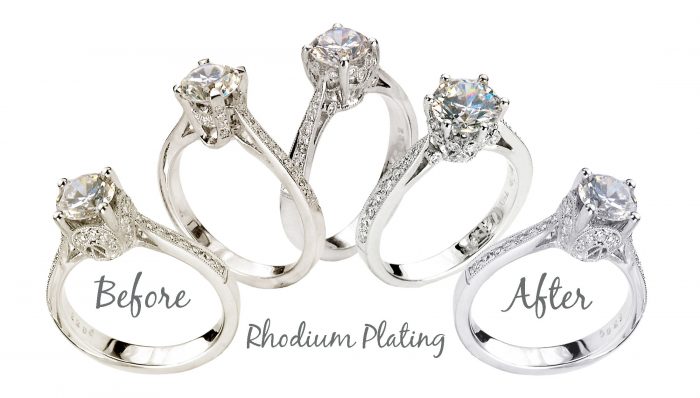
The same principle applies for white gold as for yellow gold. You can find 18k white gold, which will have about 75% pure gold, and 25% as an alloy of other metals that will increase the durability, and in the case of white gold, give it its white color.
? White Gold Pricing
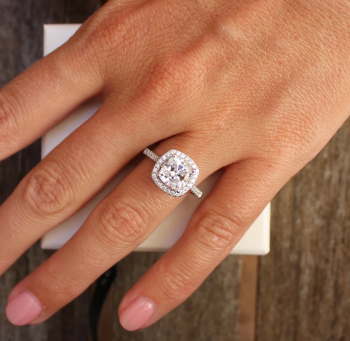
White gold is a much more affordable option compared to platinum.
Far more gold is mined every year compared to platinum and considering that you are never dealing with pure 24k gold, the price is cheaper from that standpoint as well.
A solid 24k gold ring would be incredibly expensive, but that is something that you will not find.
Instead, you can save a lot of money by selecting an 18k or 14k white gold ring, with the option of having it dipped in rhodium.
So, if white gold is cheaper, why would anyone choose platinum? There are definitely several reasons.
Let’s compare now the main differences between platinum and white gold so that you can start to decide what is right for you!
Comparing Platinum and White Gold
Let’s break down the main differences between the two precious metals. With this information, you will be able to make an informed decision about which metal is right for you.
✓ Appearance
Both platinum and white gold have a white appearance. As you will recall, platinum is naturally a white metal, where as white gold is an alloy since gold is not naturally a white metal. This will lead to differences in their appearance.
Platinum is a bright white metal that has a slight gray appearance to it. White gold will have more of a silver appearance to it. This can be seen more easily when looking at a platinum and white gold ring side by side.
Because there is a subtle difference, we highly recommend that you do not mix these metals with an engagement ring and wedding band. You will notice a difference.
If you get your white gold ring dipped in rhodium it will look very similar to platinum, but you will still be able to tell a difference.
Over time, both platinum and white gold will have their appearance change. With platinum, it will not start to turn yellow, but instead will just start to have a more dulled look to it. This can be fixed simply by polishing and cleaning it.
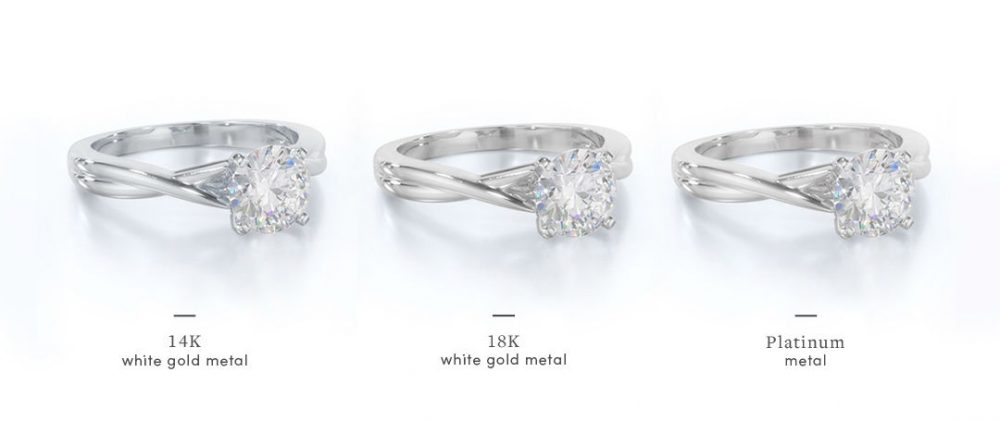
Or, you can leave it and it will have more of a patina appearance which some people like if they prefer a more vintage looking ring.
With white gold, over time the yellow gold will start to show through. If your ring is rhodium dipped, the rhodium will eventually fade away and it will need to be re-dipped.
If your ring is just white gold, it will definitely start to appear more yellow in color over time. It will need to be professionally cleaned and replated in order to bring back its white appearance.
✓ Cost
Platinum is far more expensive than white gold. How much different the cost will depends on numerous factors, but it will always be more expensive.
The difference will be more significant if you go with a lesser quality white gold. For example, 18k white gold will be closer in cost to platinum than 14k white gold.
Less platinum is mined each year compared to gold. Platinum is also heavier and a pure metal, which adds to its hefty price tag.
You may find that platinum costs as much as double the price of white gold. It is certainly a significant difference that you will have to factor into your final decision.
✓ Durability
Platinum is more durable of a metal than gold, however it is important to note that both metals are fairly durable. Platinum is stronger and is a great option for a ring that you are going to wear every day.
White gold is also a great option, and in fact, white not being pure gold, the alloy of metals actually help to make the gold stronger and more durable. It is certainly a great option for wearing every day, it just technically is not as durable as platinum.
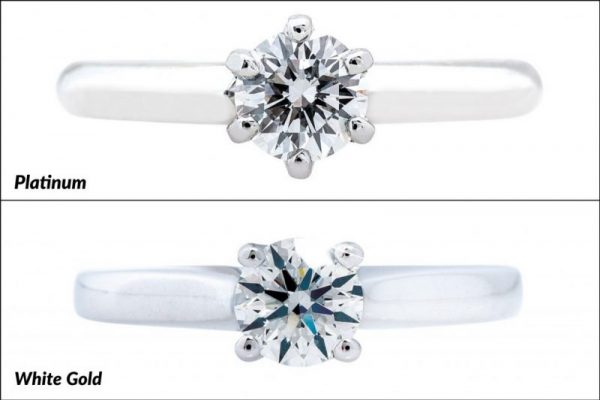
On the other hand, platinum tends to scratch more easily than white gold. When platinum gets scratched, it takes on that patina finish that a lot of people like. Scratched white gold simply looks scratched. Depending on the look you want with your ring, and how often you are willing to go and get it polished, this is something you should keep in mind.
Thankfully, both white gold and platinum can be polished and returned to their original look. If you like your ring bright and shining, you will be able to get that with both white gold and platinum.
✓ Feel
Remember that we said platinum was a denser metal? This will impact the feel of the ring. It is going to feel a lot heavier than a white gold ring.
This tends to be a very personal preference for people; some people enjoy having the weightier feel to their jewelry, while other people may find that annoying and want something that they can wear that almost ‘disappears’ and they do not feel it. If you are not sure how you feel, we recommend trying on both types of rings and seeing how they feel and what you like.

Another important aspect here is if you have sensitive skin. Remember, platinum is hypoallergenic, but white gold is not. If you are sensitive to certain metals like nickel, you may find that platinum is the right choice for you.
Most people are fine and will not react to the alloyed metals in gold, but some people will, and if that is the case, you will definitely want to go with platinum.
✓ Maintenance
Finally, maintenance is an important aspect to consider when making your decision, but it is something that we feel many people overlook.
Of course your ring is going to look pristine and perfect when you first get it, but it takes some amount of maintenance to keep it looking that way!
Both platinum and white gold will require maintenance to keep them looking in their original state. White gold typically requires more maintenance since you have to keep up with getting it cleaned and re-dipped in order to keep it from looking yellow.
Platinum will start to dull, and depending on whether or not you like the patina look of the metal, you may or may not need to get it polished from time to time. If you prefer an aged, vintage look, you may find that platinum is the perfect, low maintenance metal for you!
Making the Right Decision
With all of that information in mind, you should have a pretty good idea of what you want. You may need to try the rings on to get a feel for them, but besides that, everything else you can pretty much decide in advance based on the style of ring you want, your budget, and maintenance preferences.
While platinum may be easier to maintain, it is certainly more expensive. If you are working with a more limited budget, a great way to decide which metal to go with is to consider other elements of the ring.
Do you care more about having a more premium metal, or would you rather spend more money on a larger center stone? If you prefer a larger stone, going with white gold is a great way to save some money.
Also keep in mind that you should want the same type of metal for both your engagement ring and your wedding band (if you are planning to have a wedding ring set; some people don’t want that!).
If you do, keep in mind the cost of the wedding band as well. These rings are often bought separately and so you can forget about the wedding band cost.
A platinum band will obviously be more than white gold. Remember our recommendation; do not get a platinum engagement ring and a white gold wedding band. You will notice the difference!
If it is too expensive to have both in platinum, go with the white gold. You will still have a beautiful, durable ring.
Finally…
Platinum and white gold are two great metal choices for jewelry, especially engagement rings. Both are white metals and are very durable.
While there are plenty of similarities, there are also differences to keep in mind as you make your final decision. Platinum, while more durable, is decidedly more expensive.
While gold is a more cost effective option, but one that will require fairly regular maintenance in order to keep up its white appearance. Platinum will not change color, but instead will only dull slightly and develop a patina effect.
Now that you’ve learned all about platinum vs white gold, have you made up your mind? Do you prefer the more premium, heavy feel of platinum, or are you perfectly happy with the more cost effective white gold? Let us know!
You certainly can’t make a bad choice; you just have to pick what is right for you.

